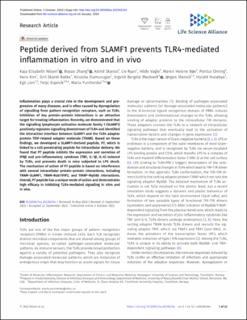| dc.contributor.author | Nilsen, Kaja Elisabeth | |
| dc.contributor.author | Zhang, Boyao | |
| dc.contributor.author | Skjesol, Astrid | |
| dc.contributor.author | Ryan, Liv | |
| dc.contributor.author | Vagle, Hilde | |
| dc.contributor.author | Bøe, Maren Helene | |
| dc.contributor.author | Orning, Pontus | |
| dc.contributor.author | Kim, Hera | |
| dc.contributor.author | Bakke, Siril Skaret | |
| dc.contributor.author | Elamurugan, Kirusika | |
| dc.contributor.author | Mestvedt, Ingvild Bergdal | |
| dc.contributor.author | Stenvik, Jørgen | |
| dc.contributor.author | Husebye, Harald | |
| dc.contributor.author | Lien, Egil | |
| dc.contributor.author | Espevik, Terje | |
| dc.contributor.author | Yurchenko, Mariya | |
| dc.date.accessioned | 2024-01-25T12:29:50Z | |
| dc.date.available | 2024-01-25T12:29:50Z | |
| dc.date.created | 2023-10-19T12:51:33Z | |
| dc.date.issued | 2023 | |
| dc.identifier.citation | Life Science Alliance (LSA). 2023, 6 (12), e202302164 | en_US |
| dc.identifier.issn | 2575-1077 | |
| dc.identifier.uri | https://hdl.handle.net/11250/3113837 | |
| dc.description.abstract | Inflammation plays a crucial role in the development and progression of many diseases, and is often caused by dysregulation of signalling from pattern recognition receptors, such as TLRs. Inhibition of key protein–protein interactions is an attractive target for treating inflammation. Recently, we demonstrated that the signalling lymphocyte activation molecule family 1 (SLAMF1) positively regulates signalling downstream of TLR4 and identified the interaction interface between SLAMF1 and the TLR4 adaptor protein TRIF-related adapter molecule (TRAM). Based on these findings, we developed a SLAMF1-derived peptide, P7, which is linked to a cell-penetrating peptide for intracellular delivery. We found that P7 peptide inhibits the expression and secretion of IFNβ and pro-inflammatory cytokines (TNF, IL-1β, IL-6) induced by TLR4, and prevents death in mice subjected to LPS shock. The mechanism of action of P7 peptide is based on interference with several intracellular protein–protein interactions, including TRAM–SLAMF1, TRAM–Rab11FIP2, and TIRAP–MyD88 interactions. Overall, P7 peptide has a unique mode of action and demonstrates high efficacy in inhibiting TLR4-mediated signalling in vitro and in vivo. | en_US |
| dc.language.iso | eng | en_US |
| dc.publisher | Alliance of EMBO Press, Rockefeller University Press, and Cold Spring Harbor Laboratory Press | en_US |
| dc.rights | Navngivelse 4.0 Internasjonal | * |
| dc.rights.uri | http://creativecommons.org/licenses/by/4.0/deed.no | * |
| dc.title | Peptide derived from SLAMF1 prevents TLR4-mediated inflammation in vitro and in vivo | en_US |
| dc.title.alternative | Peptide derived from SLAMF1 prevents TLR4-mediated inflammation in vitro and in vivo | en_US |
| dc.type | Peer reviewed | en_US |
| dc.type | Journal article | en_US |
| dc.description.version | publishedVersion | en_US |
| dc.source.volume | 6 | en_US |
| dc.source.journal | Life Science Alliance (LSA) | en_US |
| dc.source.issue | 12 | en_US |
| dc.identifier.doi | 10.26508/lsa.202302164 | |
| dc.identifier.cristin | 2186349 | |
| dc.relation.project | Norges forskningsråd: 223255/F50 | en_US |
| dc.relation.project | Samarbeidsorganet mellom Helse Midt-Norge og NTNU: 90794301 | en_US |
| dc.relation.project | Samarbeidsorganet mellom Helse Midt-Norge og NTNU: 2022/2758 | en_US |
| dc.source.articlenumber | e202302164 | en_US |
| cristin.ispublished | true | |
| cristin.fulltext | original | |
| cristin.qualitycode | 1 | |

